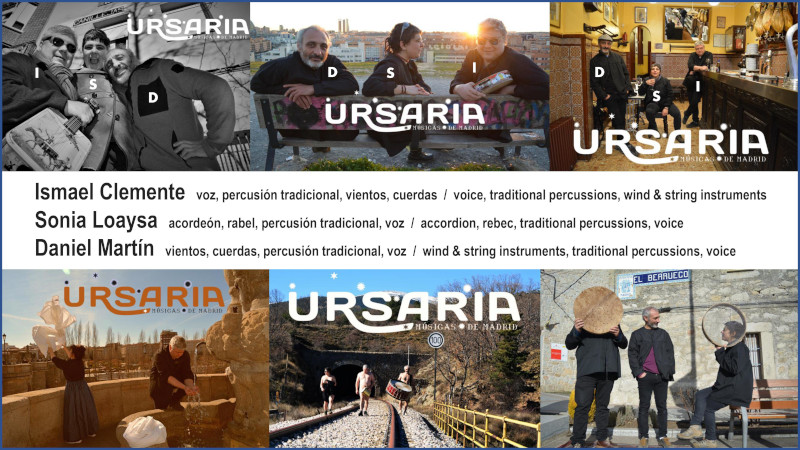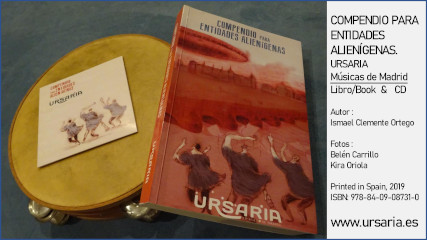
URSARIA is the folk music trio: Ismael Clemente (voice, traditional percussions, wind & string instruments), Sonia Loaysa (accordion, rebec, traditional percussions, voice), and Daniel Martín (wind & string instruments, traditional percussions, voice). These experienced musicians have consolidated their band in 2016, within a versatile artistic project that also mixes literature, theatre & comedy. They define their work as focused on the traditional music of Madrid, as the capital of Spain and as its entire region, merged between the two Castilian autonomous communities (Castilla y León and Castilla-La Mancha). But their main objective is to go far beyond a standard sampler of traditional Madrid songs. URSARIA has also written a book in which they recount a series of historical events and places that have shaped the character of Madrid. Stories that mix absolutely real facts, with realistic hypotheses of how things could have probably been (given some specific circumstances). What is the reason for such an effort? URSARIAS’s main concern is that the people of Madrid have a chronic tendency to forget and ignore their origins and local traditions.
URSARIA’s band leader is Ismael Clemente Ortego, one of the founders of the late band La Bojiganga,[53] a fun project that came to an end due to divergent opinions and affections, but that helped select the optimal team for his next exploration in the labyrinth of traditional music, and the convulsive history of Madrid & Spain in general.
It was in 2020 that Ursaria have published their book & album ‘COMPENDIO PARA ENTIDADES ALIENÍGENAS’ (COMPENDIUM FOR FOREIGN ENTITIES). A compilation of 365 pages with all kinds of stories (all written in Spanish, sorry) that describe where, when, who, how, why, in Madrid’s significant: towns, neighbourhoods, streets, mountains, rivers,… along hundreds of years of history.
Although Madrid is today one of the largest European capitals (more than 3 million inhabitants in the metropolitan area and close to 7 million in the autonomous community as a whole), it has often been defined as "a big village". In other words, although it has lived through many periods of expansion and urban development, there has always been an underlying substratum of rural life, memories, legends, traditions,... This substratum is precisely the objective of Ursaria's quest.
Consequently, this 'Compendium' travels from the centre of Madrid to the northern end of the Sierra de Guadarrama to reveal traditions and historical facts, from centuries ago to the time after the Civil War (1936-1939).

In this way, each of the book’s eighteen chapters is connected to one of the corresponding traditional songs on the CD. We can learn about eel fishing and cooking that used to take place until the middle of the 20th century in one of the streams that runs under one of the modern districts near the airport. There are legends about Galician granite quarrymen and Basque tree fellers, coming from the north of Spain, who worked in the Sierra de Guadarrama and generated the building blocks of so many palaces, churches and mansions in Madrid city and province.
We learn about the work of collecting ice and snow in those mountains (since before the 17th century), which was brought in carts pulled by oxen to the underground silos of the city centre, to be used in the kitchens of the Royal Palace, or at local fairs, before the arrival of the ice making industry.
It even describes the visit of the Schutzstaffel's Reichsführer, Heinrich Himmler, who came to Madrid in 1940 to meet the new government of his ally Spain and to explore some of the country's historical and religious sites. The story narrates his personal obsessive search for esoteric objects of all kinds, following in the footsteps of the ancient Germanic tribes who emigrated from the Scandinavian and Central European lands to the southwest of the continent (Goths, Suebi,...). This true historical fact fuels much imagination as to how things might have turned out as local Francoist hosts guide the honoured guest through Madrid's medieval underground cellars.
If the book is great fun to read, the songs in the CD are even more enjoyable, and truly show a huge step forward from their prior musical project. One of the instruments played in the record are Madrid’s hornpipes, the so called gaita serrana that we described in a past FolkWorld article.[45]
Photo Credits:
(1ff) Ursaria
(unknown/website).